Interested in travelling slowly through a tranquil country? Wondering where to go for local flavors and authentic moments? Or where you can visit a sun bear sanctuary and prepare their lunch? Laos – Useful Information for Travellers is our personal experience exploring this country in 2023. Our adventure includes Vientiane, Luang Prabang, Phonsavan and Pak Beng. We share our insights on where to stay, where to eat and drink, and things to see and do. Laos – Useful Information for Travellers reflects our travel style and aims to provide useful things to know before visiting this obscure destination.
Laos, ‘land of a million elephants.’ This might have been the case back in 1354, but now there are thought to be less than one thousand wild elephants left in the country. Land of a thousand rivers would be more appropriate these days. These rivers serve as a major transportation network, as they always have. Remote villages only accessible by long boat remain as they have for hundreds of years. Heavily bombed during the neighbouring Vietnam war, work still continues to remove unexploded mines and devices. But this hasn’t made the Laotian people resentful, far from it. They are a calm and peaceful people, and as a result, the country has a pleasant and passive atmosphere.
Why go to Laos?
Laos is a welcoming country. Its people are humble and loving. It relaxes you and you can’t help but fall into the gentle flow of each day. The natural wonders and landscapes add to the beauty of the country. Laos has preserved cultural traditions and has three UNESCO World Heritage sights – Luang Prabang, The Plain of Jars and Vat Phou. It’s a rewarding destination to visit, with parts of the country remaining largely unexplored, and you may not see any other visitors. Laos is a country with much to offer, and for whatever reason you choose to visit, it will be impossible not to be affected by the serenity of its people.
- Capital: Vientiane
- Best time to visit: October – April (wet season is May to September)
- Budget/Mid-Range/Couple: AU $100 per day
- Currency: Laotian KIP (KIP13,000 = AU$1)
- Language: Lao
- Visa: Yes
- Difficulty: 1 (1-basic & 5-challenging)
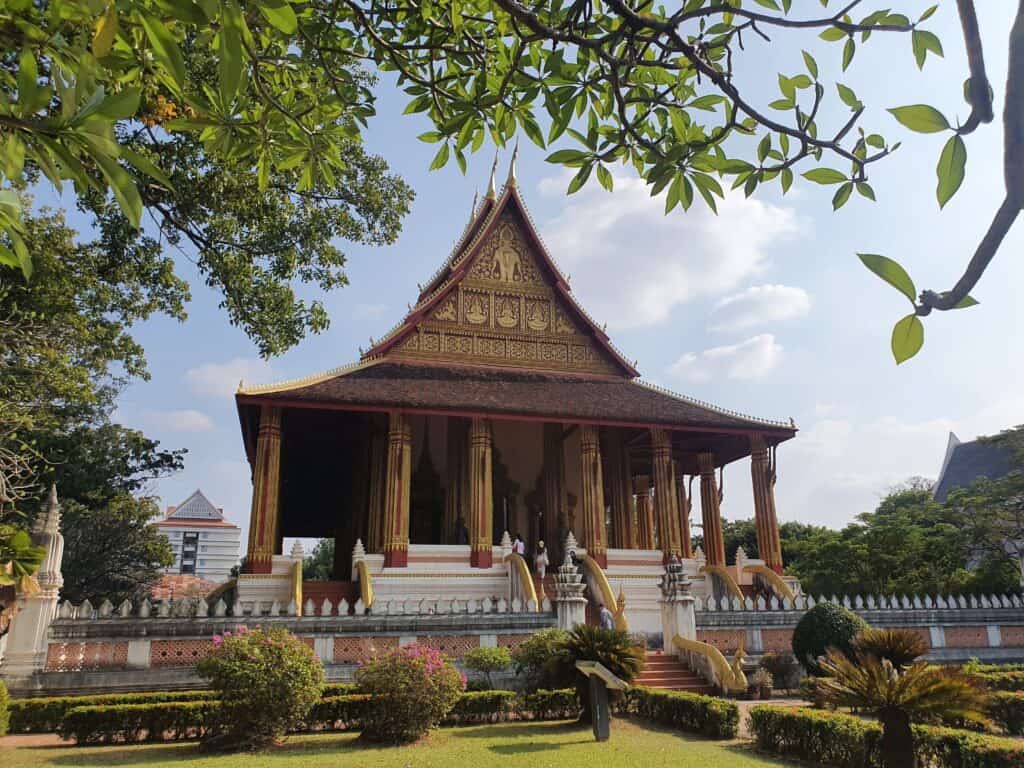
Vientiane
Located on the banks of the Mekong river, Vientiane and its people, like the Mekong, go about their lives slowly and peacefully. With a nice, chilled vibe both day and night, plenty of healthy and delicious places to eat, and enough sights to keep you amused, Vientiane is well worth a stop. Our favourite city, it’s a perfect base for heading off to the North or South of the country.
Getting to Vientiane
Wattay International Airport is a short fifteen-minute ride from downtown Vientiane. The fare was a fixed US$20. The airport is well serviced by international flights from neighbouring Asian countries. This is the quickest and easiest option. It is possible to arrive by bus from Thailand, Vietnam and Cambodia.
Where to stay in Vientiane
We stayed in an Airbnb near the Parkson Mall. Very handy location for shops, local markets, central bus station, and most attractions. Another popular area was down by the river on Th Setthathirath Road. This is the main tourist area, with ample restaurants, shops and the Night Market. Vientiane has an abundance of guesthouses and hotels for any budget. Anywhere in the central area would be a good choice, as the city is walkable, and there’s Tuk-Tuks everywhere.
Where to eat and drink in Vientiane
With a large local population of monks, it’s no surprise Vientiane has an impressive range of delicious plant-based options. Local fresh fruit and vegetable markets are abundant, making self-catering easy. The Night Market outside Parkson Mall has a variety of local food stalls and gets busy. Plus, the mall has a big supermarket with a good range of staples. There are loads of decent options for any diet, spread all over the city. The bars and eateries down by the river on Th Setthathirath Road have a lovely vibe in the evenings. We enjoyed afternoon drinks on our balcony. Cloud 9 is a liquor store with a good variety and reasonable prices. They accept US$ dollars.
- Check out Vegetarian of the Golden Age (run by monks, the food is fresh and has beautiful flavours)
- Don’t miss Coco&Co Vegan (we loved returning for awesome smoothies and sweet treats)
- Get to Khouadin Vegetarian (this delicious all you can eat vegetable buffet gets packed with locals over lunchtime, so get in early)
Things to see and do in Vientiane
COPE Visitor Centre is a museum which shares the history and effects of cluster bombs. COPE provide mobility devices to those injured by cluster bombs and is a wonderful charity to support with a donation at the end of your visit.
The Buddha Park is a nice excursion. To get to the Buddha Park, we caught bus 14 from Central Bus Station. It leaves every half hour and took about forty-five minutes. The park is only small so an hour is enough time to explore it.
Wander around the city in the day, include a visit to Patuxai War Monument, and some of the many Wats (temples). We walked around Vientiane daily, visiting a new Wat, walking along the river, finding a curry for lunch, meeting street vendors and buying beautiful fruits. A cool way to get a feel for a place.
Have a Thai Massage. Utopia Massage was excellent. Great prices too.
The Night Market has a great atmosphere. There are some nice spots along the river to sit with a cold drink and do some people watching.
Getting around Vientiane
Tuk-Tuks are everywhere, waiting to whisk you away. We walked most of the time, as it was a pleasant city to explore on foot. You can walk across the city in forty minutes. There are plenty of scooters around to hire, with bicycles popular too. Tour operators have offices in the busy areas and will take you anywhere for a negotiable price. Additionally, Vientiane has a good local bus service which will take you outside the city.
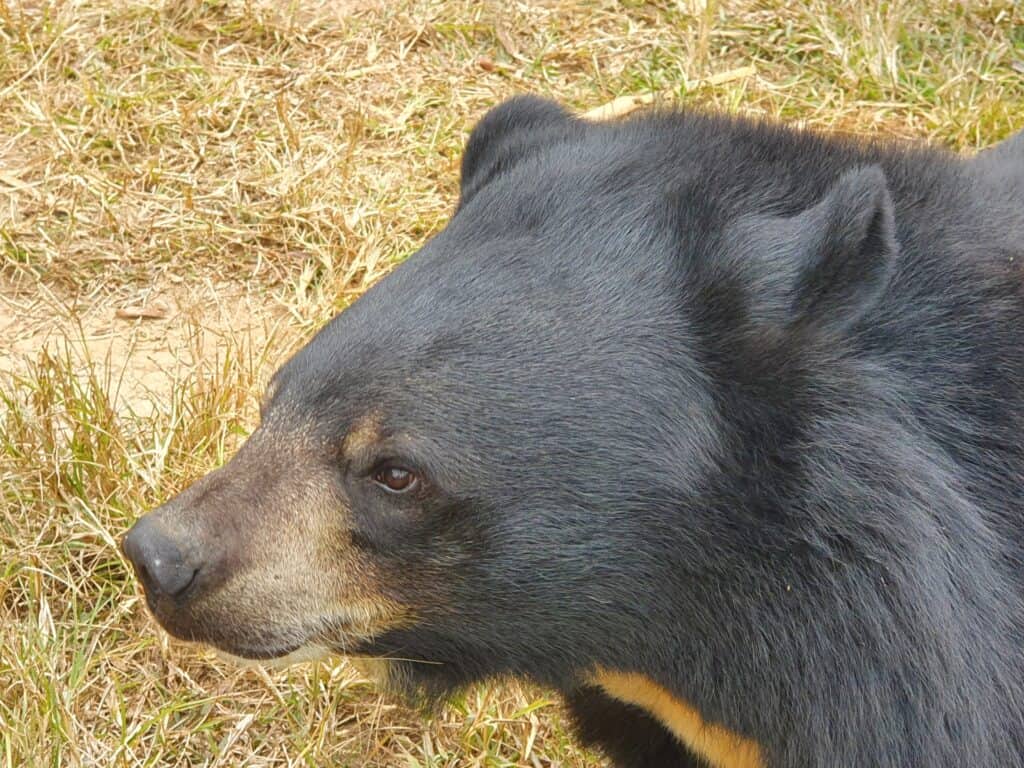
Luang Prabang
Luang Prabang is a UNESCO World Heritage Site and offers a rich cultural experience. Great location with the Mekong on the Western side, and the Nam Khan river on the Eastern side. With morning monk ceremonies, an attractive old town and enough sites and day trips to keep you busy for a week, Luang Prabang is deservedly on all itineraries. Good transport connections make it a great base from which to explore the Northern areas of the country. It’s a little more expensive than other cities/towns, and there’s lots of tourists.
Getting to Luang Prabang
Luang Prabang has an International Airport and can be easily reached from neighbouring countries. A short ten-minute ride from the airport will then have you in the heart of Luang Prabang. We arrived on the new fast train from Vang Vieng, this took one and a half hours. It was then a quick twenty-minute van ride into Luang Prabang.
A slow boat from Pak Beng is also a popular way to arrive. This takes eight hours. The terminal is a ten-minute scooter ride, out past the airport, on the river. Tickets cost KIP150,000per person. Expect to pay KIP50,000per person for the trip from the ferry terminal into town.
Where to stay in Luang Prabang
Guesthouses are everywhere. Airbnb are a little harder to find. We found an awesome one down near the Sofitel Hotel, a great area, with a twenty-minute walk to both the Southern Bus Station and Night Market. You really can’t go wrong when choosing an area to stay. Expect to pay more for a view of the river. The Old City has the majority of cafes and bars, and the early morning Alms Giving Ceremony. Options for every budget. Good idea to book ahead in peak times.
Where to eat and drink in Luang Prabang
Restaurants and cafes are all over the place. Some really nice spots to eat on the river and enjoy the sunset. Standards vary, so have a good look around. The Morning Market is a great place to find fresh fruit and vegetables if you are self-catering. There are some nice local places to eat over on Kingkitsarath Rd, where it’s not as busy as the Mekong side.
- Don’t miss Two Little Birds Cafe (we loved the smoothie bowls and green curry)
- Get to the Night Market outdoor food court (good vibes and plenty of options, gets busy)
- Check out LPMC ‘Luang Prabang Motorcycle Club’ (decent selection of beers and spirits, nice tunes, comfy seating, good for people watching)
Things to see and do in Luang Prabang
Wander No surprise, lots more Wats (temples) to see. Strolls along the river and around the Old City never tire, plus there are lots of nice spots to stop for a coffee, a meal or a drink. It’s interesting to walk the back streets and see how the locals live.
Free the Bears Sanctuary This place isn’t open to the public, bookings only at freethebears.org. The cost was US$60 per person for a three-hour experience. There’s over 80 sun and moon bears, all rescued and preparing for release. Also, red pandas, Savannakhet deer, monkeys, and sometimes pangolins. A great initiative, and well worth the donation/cost. It’s not easy to reach, having only opened in 2017, not a lot of Tuk-Tuk drivers know where it’s located. It took us about an hour on a scooter and we followed the small blue signs to the National Park. Very bumpy and dusty, but fun. You can request a pick up and drop off for US$40. They will drop you a pin of their location after booking.
Kuang Si Falls and Tat Kuang Si Bear Rescue Great spot but very touristy, so it gets busy. It took us forty-five minutes on a scooter. Easy enough to find. Sealed road all the way. Park your scooter in the carpark, purchase your ticket, and jump on the electric bus to head up to the entrance. Free the Bears have a smaller Bear Rescue Centre here (included in your entry ticket).
The Morning Market is worth the early start. You’ll find everything from fresh seasonal fruit and vegetables, to fried rat and toad, along with crafts and souvenirs. It’s located down by Wat May Souvannapoumaram.
Day trips to experience rice farming and the Elephant Sanctuary are popular, as are boat trips to waterfalls and sunset cruises.
Getting around Luang Prabang
Luang Prabang is easy to explore on foot, bicycle, Tuk-Tuk or scooter. We walked the majority of the time and used a scooter for our day trips further afield. Loads of hotels and guesthouses offer the use of bicycles, check with them before you book.
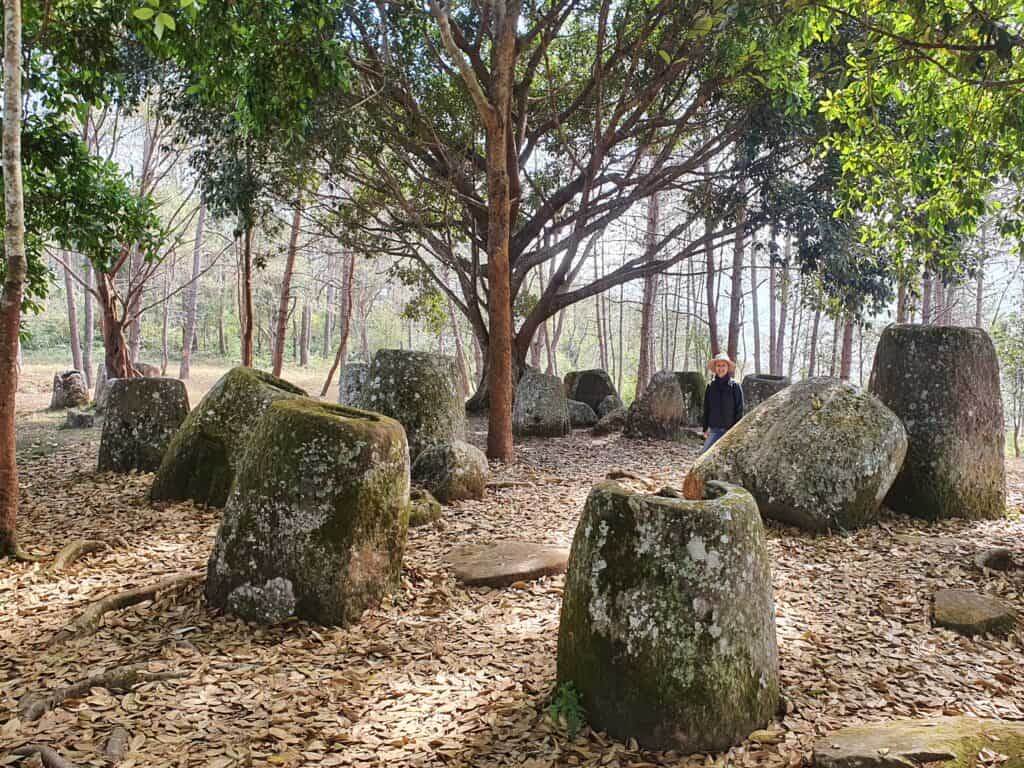
Phonsavan
Phonsavan is a sprawling city, surrounded by countryside. There is quite a bit around town to keep you occupied for a few days. Sitting at over 1000 metres above sea level, it cools off in the evenings, and can get a bit windy. The Plain of Jars, a UNESCO World Heritage Site, can be found a short distance from Phonsavan. We loved our time here. It’s well worth the long van ride.
Getting to Phonsavan
We arrived by van from Luang Prabang. The journey took seven and a half hours. It’s a slow ride, and not the best road, but the scenery is great. You can also catch the van from Vang Vieng, which takes around eight hours. The bus station in Phonsavan is on the outskirts of town, a thirty-minute walk into the centre. If you are lucky, there may be space on a Tuk-Tuk, which will get you from the bus station to your guesthouse. There is only one van per day, so plan ahead. You can get a ticket at guesthouses and tour companies around Luang Prabang and Vang Vieng. For trips back to Luang Prabang and Vang Vieng vans depart at 8.30am. You have a half hour stop for lunch, with the driver pulling over randomly for everyone to pile out and take a wee on the side of the road.
Where to stay in Phonsavan
Plenty of affordable guesthouses and hotels all over the place. Basing yourself in the centre of town will give you easy access to restaurants, tour options, and scooter hire. We stayed a little out of town and used the free bicycles that our guesthouse provided. Not as many travellers as the major cities, so prices are cheaper. Many places include breakfast.
Where to eat and drink in Phonsavan
Phonsavan doesn’t get the visitor numbers of Luang Prabang, so not all of the restaurants have English menus. There’s not as many options, or variety, as other cities either. Plenty of good fruit and vegetables, with a couple of large markets, and smaller stalls along the main roads. Watermelons are everywhere, truck loads! Try the Nashi pears, they are delicious.
- Top spot is Bombies (great yellow curry, the friendly and knowledgeable owner does Plain of Jars tours. Decorated with old war relics)
- Check out Nisha Indian restaurant for dinner (best range of vegetarian in town)
- Get to Simmary Restaurant (green building on the main street, English menu, busy with locals and travellers, quick service, great prices and large portions)
Things to see and do in Phonsavan
Plain of Jars is the obvious attraction here. There are more than 90 sites, Sites 1,2 & 3 being the main ones. Site 3 was our favourite, set amongst trees, and a pleasant walk through rice fields. It’s around forty-five minutes by scooter from town. Site 2 is also very scenic, on top of a hill under some trees, taking around thirty minutes by scooter from the town centre. We had the site to ourselves which added to the feel of the place. Site 1 is only ten minutes from town, has the most jars, and the most people! Very touristy. You pay to park, then you get a buggy ride to the site, or walk fifteen minutes. Although Site 1 has the most jars, we found it the least scenic, being in an open field near the airport. It does have one of the largest jars. All 3 sites have a ticket booth. The signage for Sites 2 & 3 is very small so keep your eyes peeled.
Ban Napia,or the Spoon Village, is a worthwhile trip. The locals melt down old bombs and metal to make spoons and trinkets, then sell them for a small fee. The whole family gets involved. Really good cause. It was hard to find. It’s about fifteen minutes from Site 3. Take a left when you get back to the main road after Site 3, then when you reach the first village, go right over the bridge, then look for the Spoon Village sign on the right shortly after the bridge. Follow this road, past the power station, over the hill, and down the other side. You will see the stalls on the side of the road.
The Organic Mulberry Farm, near the Bus Station on the main road, was a really interesting visit. You get a free tour of the farm and silk factory to see the whole process of how everything is made. There is a nice little shop at the end to buy some mulberry wine and tea. Not a bad drop, another good cause. It’s an easy bike ride from the city centre.
The Xiengkhoung Provincial Museum was worth a look. Some interesting displays and four short movies to watch.
Getting around Phonsavan
An organised tour or hiring a scooter is the only way of reaching Sites 2 and 3. Site 1 could be reached by bicycle. You can walk or bike to the museum and other points of interest in town.
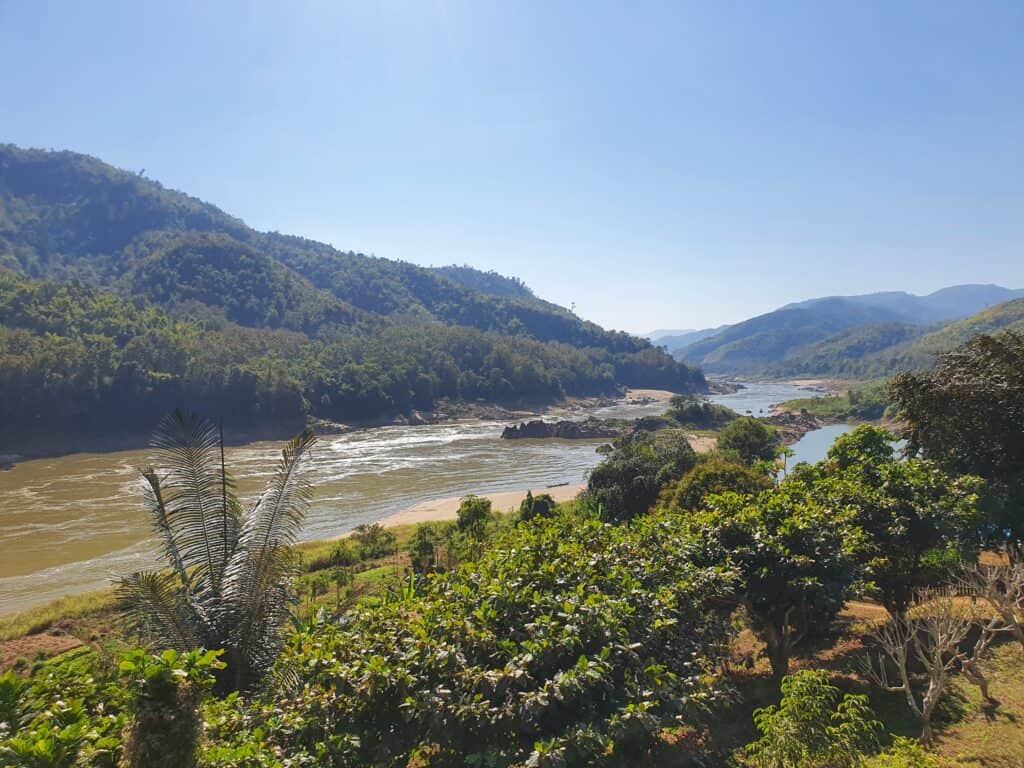
Pak Beng
Pak Beng is the halfway point on the slow boat journey from Luang Prabang to Huay Xai (Thailand border). It’s a small village, positioned at a sweeping bend in the Mekong. You will spend a night here, but if you have the time, spend a couple. Busy in the mornings and in the evenings, when the slow boats arrive and depart, it’s very quiet during the day. Great place just to chill out. Not a great deal to do around town, the main excursion being the Elephant Sanctuary across the river.
Getting to Pak Beng
The slow boat takes eight to nine hours to Luang Prabang and seven to eight hours to Huay Xai. It’s comfortable enough with nice scenery. Take food, drinks and a book. You can only buy basics on board such as beer, coffee and 2minute noodles. If you are in a hurry, speedboats make the trip in half the time.
Where to stay in Pak Beng
Lots of guesthouses and hostels, who will pick you up and drop you off at the slow boat landing. Some nicer places around to splurge, with cool views over the river. Very small village, so you won’t be far from the action wherever you stay.
Where to eat and drink in Pak Beng
We found some great places to eat, and the owners were lovely to chat with. The food here is freshly made and definitely worth the wait. Places get busy around the time the boats arrive, so avoid the crowds if you can. Lunchtime is really quiet, so you’ll usually have the restaurant to yourself.
- Stop at Sabaidee restaurant (great selection and setting, beautiful plant-based options)
- Check out Hasan Indian (very friendly, family run, the samosas are great)
- Get to Sanctuary Pak Beng for a drink on the balcony overlooking the river (best selection of wine)
Things to see and do in Pak Beng
The Elephant Sanctuary is straight across the river. They will pick you up with their boat from the Sanctuary Pak Beng Hotel around 8.30am. You can choose from a number of different experiences. We took the two-hour option (US$50 per person), it was awesome! All proceeds go to the conservation of the elephants, and the team here are doing an amazing job. There is a restaurant and a small shop to visit at the end of the tour.
Wander up the main street to the small local market up the top of town. We got some fruit and peanuts and enjoyed engaging with the locals. Stop at a local restaurant on your way back, some lovely options.
Getting around Pak Beng
You can walk anywhere around town.
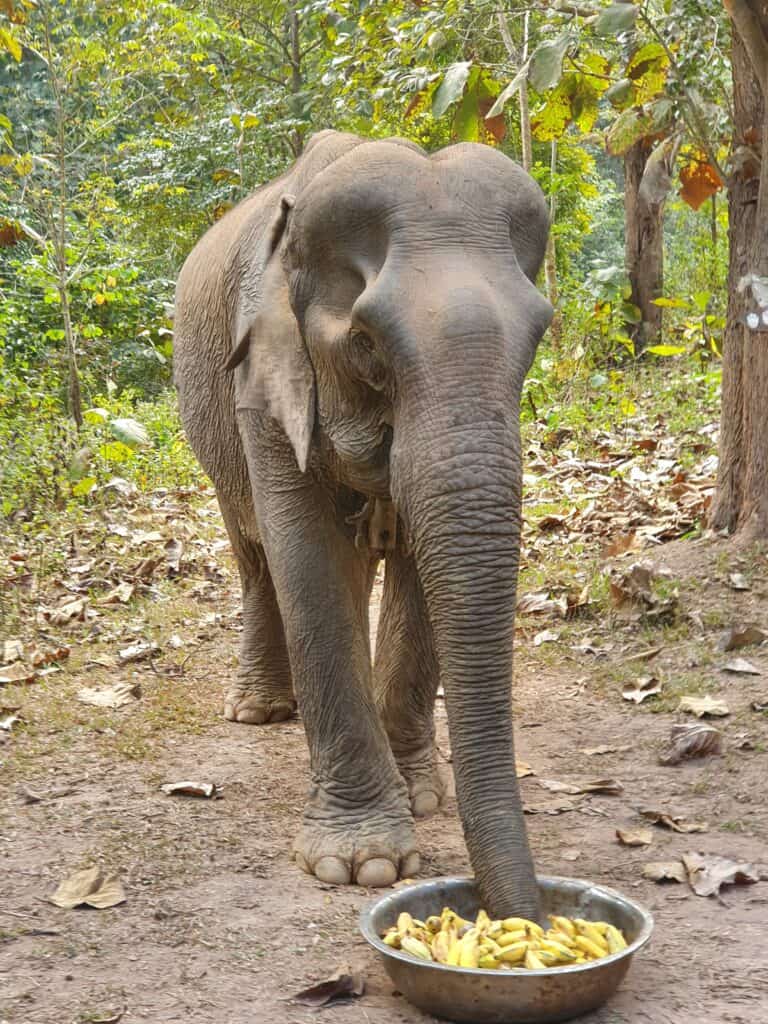
Getting to Laos
Access is easy, by plane, bus or boat, from neighbouring countries. We flew from Bangkok to Vientiane. Laos has two International Airports, Vientiane and Luang Prabang. It is also popular to enter via Chiang Rai, over the Friendship Bridge, which connects with the slow boat at Huay Xai.
Useful things to know before visiting Laos
People are friendly and helpful.
We always felt safe.
Don’t expect everyone to speak English or French, Lao is the main language. Learn a couple of phrases, “sabaidi” means “hello”.
Things take time, don’t be in too much of a hurry.
There’s plenty of delicious eating options for Vegan’s and Vegetarians.
A lot of the roads are in poor condition, road travel can take time.
Visas are available on arrival at the airport. US$40. You don’t need to bring a photo.
Currency exchange is available at the airport.
The duty-free shop is very small and limited.
Final thoughts on travelling in Laos
Laos is a country you will want to return to. It’s a place where you could spend months wandering around enjoying the rich culture and heritage. The delicious food, welcoming locals, and its affordability, make it an even more attractive destination. Things here happen slowly. It’s a place where the slower you travel, the more you will experience. It’s a country that rewards people who want to explore its remote corners and take the time to reach them. Laos doesn’t get the traveller numbers of its neighbours (yet), so you will often have attractions to yourself. Hidden gems are waiting to be discovered. However, with highspeed trains and motorways under construction, visitor numbers are bound to skyrocket. It won’t stay this way forever. A change is happening in Laos, for the better or worse remains to be seen.
